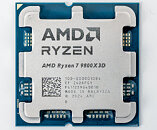Friday, April 4th 2025
Eight-Core CPUs Become the Most Popular Choice of PC Users, CPU-Z Stats Show
CPU-Z's Q1 2025 validation data indicates a new trend in CPU core count preferences among PC users. Eight-core processors now account for 24.7% of all validations, a significant increase of 32.6% compared to previous data. In contrast, six-core processors have declined to 22.5% of validations, down by 6.9%. The higher core count of eight-core CPUs aligns with the increasing demand for multithreaded performance in various computing environments, from professional workstations to high-end gaming systems. Market share figures also reveal adjustments in consumer preferences regarding CPU manufacturers. Intel retains a majority of presence with 56.3% of the market. However, AMD's share has risen notably at 43.7%, representing a 16.6% increase from the previous year.
The shift in market shares suggests that users are increasingly drawn to AMD's offerings, which include competitive eight-core processors. A key contributor to the trend toward eight-core CPUs is the rising popularity of specific models. The Ryzen 7 9800X3D, for example, has significantly impacted this new statistic, becoming the most popular CPU according to the CPU-Z validations. This indicates that users are interested in eight-core offerings with 3D V-Cache technology for increased gaming performance. The shift away from six-core configurations, which now represent a smaller portion of the validation data, shows that eight cores are now a sweet spot for many gamers. For multitasking and gaming, it seems like a perfect choice.
Sources:
Valid x86, via VideoCardz
The shift in market shares suggests that users are increasingly drawn to AMD's offerings, which include competitive eight-core processors. A key contributor to the trend toward eight-core CPUs is the rising popularity of specific models. The Ryzen 7 9800X3D, for example, has significantly impacted this new statistic, becoming the most popular CPU according to the CPU-Z validations. This indicates that users are interested in eight-core offerings with 3D V-Cache technology for increased gaming performance. The shift away from six-core configurations, which now represent a smaller portion of the validation data, shows that eight cores are now a sweet spot for many gamers. For multitasking and gaming, it seems like a perfect choice.

37 Comments on Eight-Core CPUs Become the Most Popular Choice of PC Users, CPU-Z Stats Show
Some/many AI models may fall under the memory-intensive umbrella, but we are talking about a niche that is highly cloud-centric. People "doing AI" as in who? The rando trying to implement some
plagiarism enginegenAI or SAM locally? I'm with you. The LLM end user? Those run on their own accelerators (or connect to cloud), afaik. The researcher/developer? They're mostly on Colab. The people who do training? Yeah I think they are looking at things at a different scale...Meanwhile, look at any random, locally-running, number-crunching, production/engineering/scientific/whatever application, and you'll very likely find it recommending as many cores as you can throw at it, as it has been for decades.
Now let's make 16-Core at the same price points to progress, or will we be stuck for 10 years like with Intel? I don't see a 3rd player shaking up the market.
And cloud rendering services are a dime a dozen these days. But rendering, unlike pip installing some genAI crap, often has economic value, and no "free" cloud service exists for it.FreeCAD needs an entire separate computer to handle the all the googling of how to fix its issues and do even basic CAD ops on it. :roll:That should have been Qualcomm (and Apple, if you were to look past their exclusivity), but they themselves are serving as an example that we are not heading in the direction you -and I- are hoping for. Marketing and development are shifting from actual processing performance to those "NPU" gimmicks.
I'm too lazy. I could even get a ryzen 7700 tray and sell my 7600X for a price difference of 40€. I do not need any more performance as of now. 2x32GiB DRAM / radeon 7800X limit my gaming experience. For gnu gentoo linux the two months in 2023 showed me that a ryzen 3 3100 is enough with 1x 8GiB 3200mt/s DDR4 @ B550. I highly doubt I will find any games / any cheaper graphic cards in the next 2-3 years which motivate me to upgrade. (KCD 2 maybe)
gentoo compiles source code. I saw the differences since 2006 in hardware changes or upgrades or side grades.
5800x = sidegrade = nearly equal = 7600x
7500f / 7600 / 7600x = buy the cheapest and be happy (when you do not care for the cpu graphics)
I always read about microsoft flight simulator and maybe those big city builder games which benefits from high core count and high 3d-cache.
For example a 9700X is $280 at MC hard to argue with that and other than Zen 5’s weirdly high idle power consumption it’s an excellent option.